India and Burma
India, already in the 4th millennium B.C. a centre of culture, had extended sea commerce to Arabia and Africa. Around 1400 A.D. India was submitted by the Mongols, in 1600 Queen Elizabeth founded the East India Company and in the 18th century the Moguls were deprived of power by the British Empire.
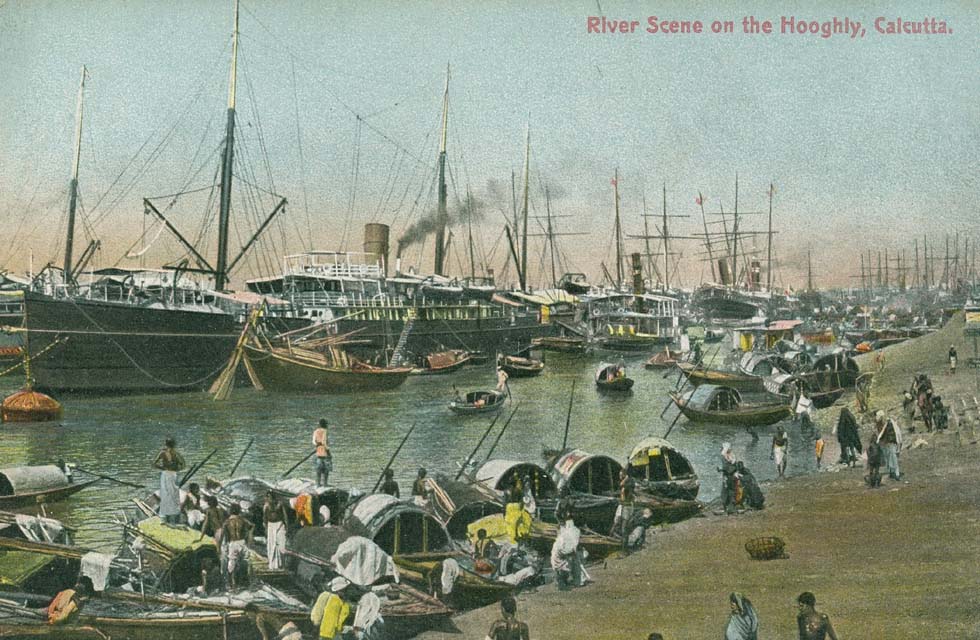
Calcutta, the Hooghly (old card, coll. WS)
Indian Mail
From the 30s of the 19th century until 1854 the East India Company maintained a regular mail steamer service between Suez and Bombay. The future however belonged to the P&O, which started mail services Suez - Calcutta in 1843 and Suez - Bombay as well as Bombay - China in 1852. In 1858 they got a new mail contract, including many branch lines. "The services were divided into sections in the fleet list that year, these sections were Southampton - Alexandria, Malta - Corfu, Suez - Calcuta, Bombay - Suez, Bombay - China, Suez - Sydney, Hong Kong - Shanghai, Hong Kong - Manilla and Suez - Maritius - Isle of Reunion", wrote E.A. Ewart. For the Indian Mail and the historical background see the main chapter Indian Ocean.
To Burma
During the war for conquering Burma in the 20s of the 19th century, the first mails were conveyed from Calcutta, using among others the little steamer "Enterprise", acquired by the Navy. After a second Burma war, the Calcutta and Burmah Steam Navigation Co., founded by William Mackinnon and Robert Mackenzie, got a mail contract for Calcutta - Rangoon in 1856. With the little steamers "Baltic" and "Cape of Good Hope" they started a service Calcutta - Akyab - Rangoon - Moulmein. At Rangoon their steamers connected with the Irrawaddy Flottila, which undertook river traffic to Mandalay. Under the new name British India Steam Navigation Co., adapted in 1862, the company became known as the British India Line and extended services to Singapore and China. Towards the end of the 19th century there were, apart from a London - Calcutta route, services Bombay - Galle - Calcutta, Calcutta - and Madras - Rangoon - Moulmein and other branch lines. The Burma mail from England was conveyed by train from Bombay to Calcutta Diamond Harbour, where the British India Line took over. In 1913 Railway News described the conveyance of the mail in a special van, attached to the 'Imperial Mail' Bombay - Calcutta - Howrah, "which it slips while running through Naihati Station". From there a locomotive hauled the single mail van to Diamond Harbour. From 1877 a railway from Rangoon to Prome on the Irrawaddy shortened the river route in Burma and in 1894 the Burma Railway and no longer the Irrawaddy Flotilla provided the fastest direct connection to Mandalay. Around the turn of the century the Madras Chamber of Commerce proposed in vain a new route for the mail: P&O London - Bombay, train Bombay - Madras and British India Line to Rangoon. A typical black/white British India steamer, e.g. the "Erinpura" on a Madras - Rangoon run between the wars, conveyed 51 first-class, 30 second-class passengers and 659 natives all the voyage on the deck. When in 1938 ten thousands of prisoners had completed the Burma Road, a new way to China was opened, but in 1942 the Japanese conquered Burma.
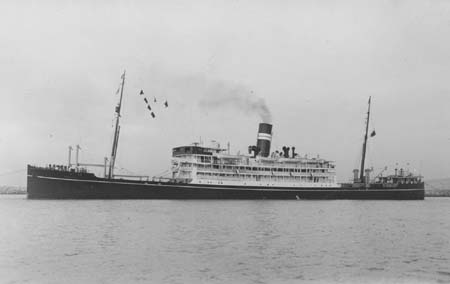
"Modasa", British India Line (old card, coll. WS)
|
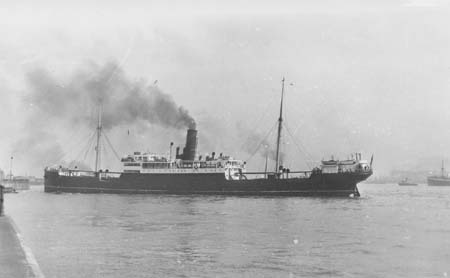
"Bhamo" of 1908, Henderson Line (old card, coll. WS)
|
Early competitors on the Burma route where the Hendersons, owners of the Albion Line, engaged in the New Zealand trade. In 1865 Hendersons formed the Irrawaddy Flotilla Co. for the Burma inland services. Opening of the Suez Canal was followed by ordering steamers for a Glasgow - Rangoon route in 1871. Henderson's Direct Steamers competed with the British India Line. Albion was given away in 1882 forming Shaw, Savill & Albion. Finally, in 1952, the Henderson Line was acquired by Elder Dempster Lines. Another competitor on the Burma route was the Bibby Line, which got in 1920 their first steamer surpassing the 10,000 tons.
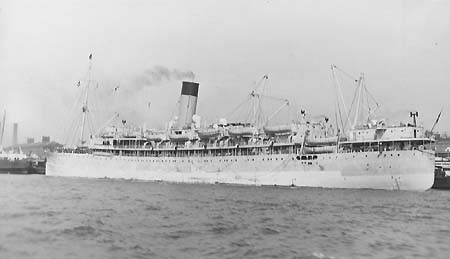 "Derbyshire" of 1935, Bibby Line (old card, coll. WS)
"Derbyshire" of 1935, Bibby Line (old card, coll. WS)
In the years before World War I, mails for Singapore were conveyed every two weeks, alternating with the direct P&O liner, by P&O to Bombay, train to Nagapattinam (Negapatam) and then by a British India liner, coming from Madras, to Penang and Singapore (according to postal historian R. Kirk).
Other Lines
Before WWI there were also other branch line services on various routes, by Messageries Maritimes and Oesterreichischer Lloyd Colombo - Calcutta and Navigazione Generale Italiana Bombay - Singapore - Hong Kong. Nippon Yusen Kaisha operated a Bombay Line and a Calcutta Line to Japan. And of course always, also after WWII, the British India Line preserved its dominance. In 1947/48 they introduced new 10,000-tonners, the "Kampala" and "Karanja", on the Bombay - Mombasa - Durban route. The successor P&O Strath Service offered a service from Bombay via Karachi, the port of Pakistan, to the Persian Gulf still in the 70s - see chapter Arabia. Rather unknown in Europe remained the Bombay & Persia Steam Navigation Co., founded in 1877. Already in early years, pilgrims' traffic was handled. In 1939 the company was renamed Mogul Line.
Sri Lanka
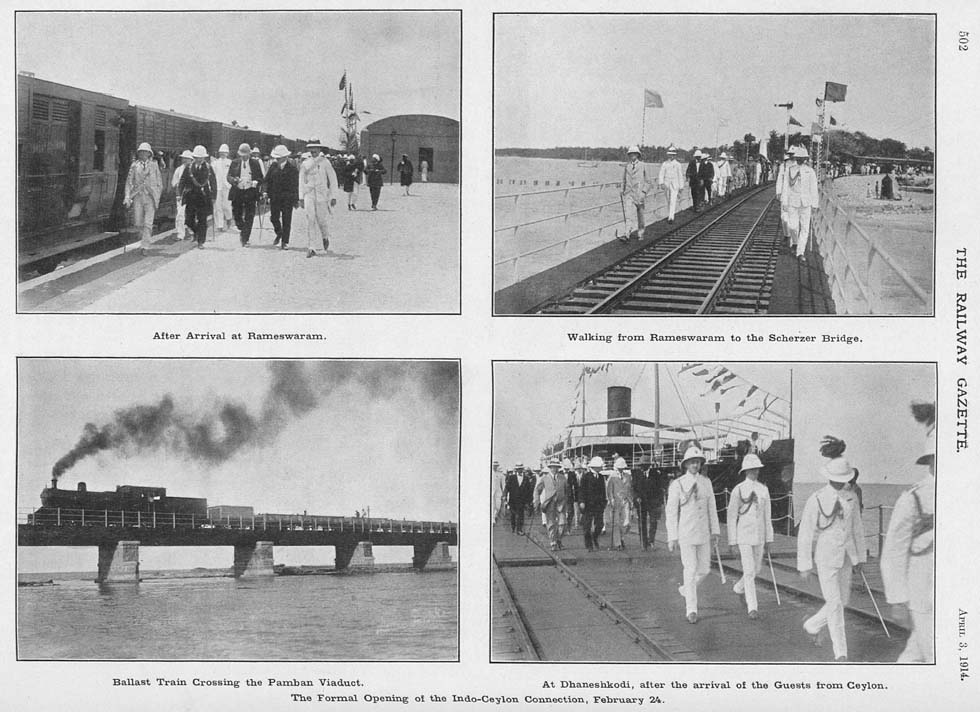
Opening of the new route in 1914 (coll. Deutsches Museum Muenchen)
The most-frequented ferry route of South Asia in the past has been the India - Ceylon passage. In the 19th century the mail from India had been carried by foot runners to Point Calimere and from there by native catamarans to the Island. From 1898 passengers could travel by a meter-gauge train to Tuticorin in the utmost south of India, where steam boats brought them to the British India liner "Katoria", departing for Colombo. In 1914 a new route was opened after the small islands of the so-called Adam's Bridge were connected with the mainland by a "Scherzer Rolling - Lift" railway bridge. At the Dhaneshkodi pier the new steamers "Curzon", Hardinge" and "Elgin" of the British India Line waited for crossing the Palk Strait to Talaimannar, where the broad-gauge train to Colombo started. As soon as a broad-gauge main line was built from Madras southward, a railway bridge should have replaced the steamers, but that project never has been realized. In 1948 Sri Lanka, as Ceylon was renamed then, achieved national independence. When in 1965 the pier at Dhanuhskodi was destroyed by a hurricane, the ferry connected only the nearby Rameswaram with Talaimannar. It was the "Ramunajam" of the Shipping Corporation of India, which sometimes not even waited for the late-running train. In 1983 the ethnic conflict in Sri Lanka escalated and soon Cook's Overseas Timetable informed about the shipping route: "Service suspended indefinitely". Still in the new century, the train from Colombo terminated at Vavuniya and Talaimanner had to wait for getting once again a train connection.
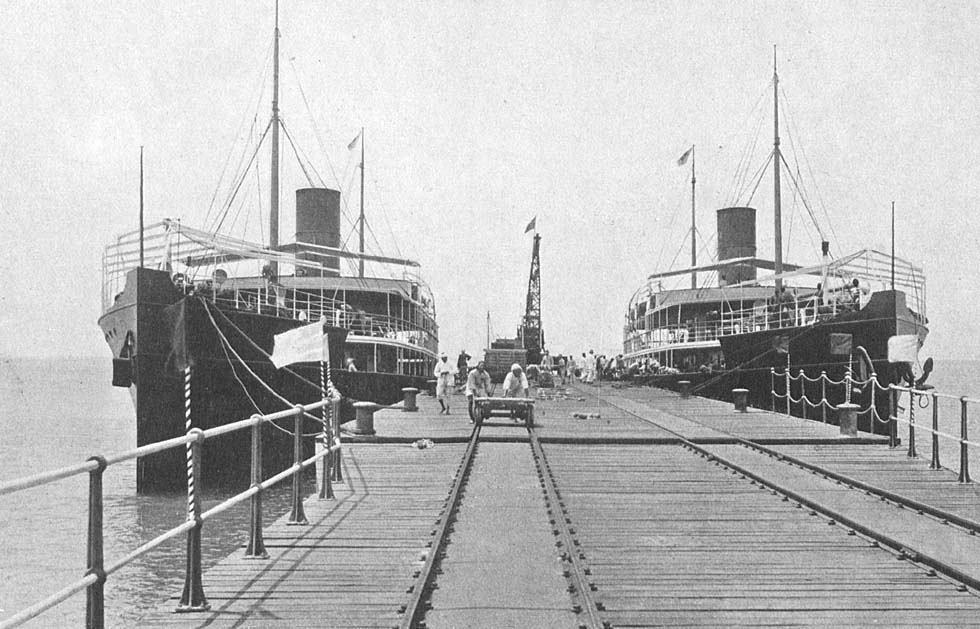
"Elgin" and "Hardinge" at Dhaneshkodi Southern Pier (Railway Gazette 1914, Deutsches Museum)
A New Epoch
Mahatma Gandhi has accomplished the liberation of India. Against his will however, the country was divided up between Hindu and Muslim religion, the latter dominating the new state of Pakistan. The Pan Islamic Steamship Co. of Pakistan became known for the pilgrims' services from Karachi to Jeddah in Saudi Arabia.
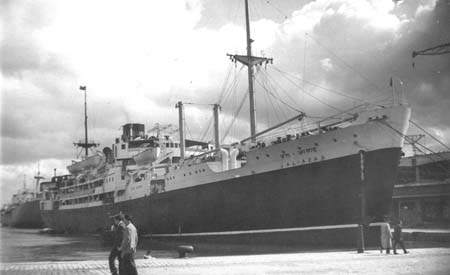
"Jal Azad" of India (photographer anonymous, coll. WS)
|
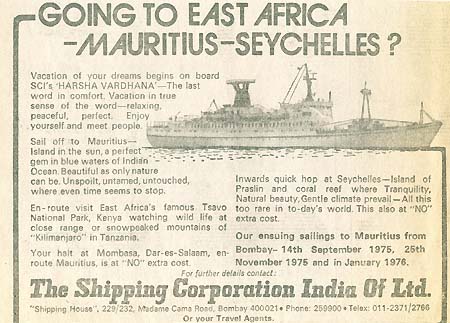
"Harsha Vardhana", Shipping Corporation of India (coll. WS)
|
In 1961 the Shipping Corporation India (SCI) has been established by amalgamation of the Western Shipping Corp. and the Eastern Shipping Corp. In the 1970s the only passenger service to Africa was offered by SCI with the "Harsha Vardhana", connecting Bombay with Mombasa in Kenya, calling also at Mauritius Island. Indians living in Africa and also European globetrotters were among the passengers. The service ended after a few years. In the 1980s, long after the British India Line had disappeared, the Shipping Corporation Of India provided services Madras - Calcutta and Madras - Singapore for some years with the "Chidambaram". Damodar Bulk Carriers were listed with a service Bombay - Kuwait. The Mogul Line and the Shipping Corporation Of India offered also services from Bombay to Jeddah. The "Nicobar", a 14,000-tonner built in 1991, and her two consorts were considered the largest passenger ships in the Bengal Gulf. In 2010 the trade press reported introduction of the passenger ship "Arabian Sea", government-owned, on Lakshadweep services and the home page mentioned passenger-cum-cargo vessels, but not the pilgrims' services. Passenger services Bombay - Goa were offered by Mogul Line, but the timetable warned: "Does not operate during Monsoon season." And of course there are various local and inter-island services.
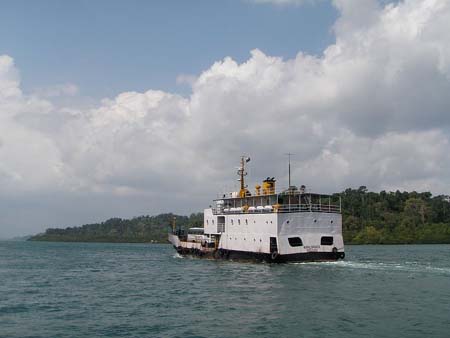
Local ferry at Baratang, Andaman Islands, 2009 (Biswarup Ganguly, via Wikimedia)
|
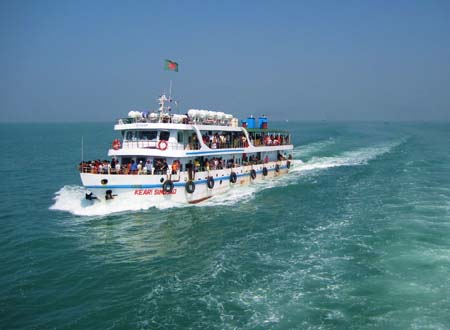
"Keari Sinbad", Bangladesh Inland Water fleet, in the Bay of Bengal, 2007 (Russel John, via Wikimedia)
|
Bangladesh, the former East Pakistan, separated from Pakistan in 1971. The government-owned Bangladesh Shipping Corporation was constituted in 1972 and operated from 1974. The company acquired in 1977 the passenger motor-ship "General Mangin" (1953/11,684 gt) from France and employed her on Chittagong - Dubai services until 1980, but the activities are concentrating on cargo shipping. The Bangladesh Inland Water Transport Corporation, founded in 1972, maintains inland and coastal services, connecting with trains at Chittagong and Khulna.
Tourism
There are many unknown services on the coasts of the Indian Ocean, also for tourism. Even in Burma, now Myanmar, it emerged. Rudyard Kipling once could write: "Come you back to Mandalay, where the old flotilla lay: Can't you 'ear the paddles chunkin' from Rangoon to Mandalay?" Also now river boats are connecting Rangoon (Yangon) with Mandalay, with a stopover at Pathein. And for wealthy tourists the "Road to Mandalay" started cruising on the Irrawaddy for Orient Express Hotels. The boat is the former "Nederland" of Koeln-Dusseldorfer, transferred from the Rhine.
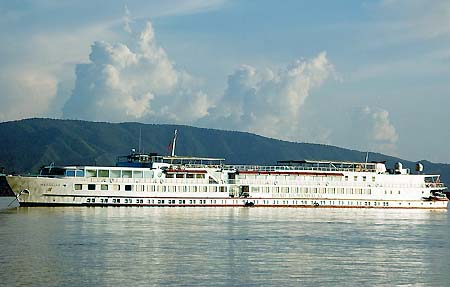 "Road to Mandalay" on the Irrawaddy (Colin Houston, via Wikimedia)
"Road to Mandalay" on the Irrawaddy (Colin Houston, via Wikimedia)
One of the tiny vessels for island tourism is the mini-cruise ship "Atoll Explorer", offering inter-island cruises on the Maldives. And also for journeys from Goa to the Lakshadweep and Andaman Islands and on longer routes regular cruises were offered. The ship was the 5,250-ton "Ocean Odyssey" of Indian Ocean Cruises, built in 1965 as "Eros" for Typaldos, then cruising as "Jason" for Epirotiki and Royal Olympic Cruises, in 2005 taken over by Indian Ocean Cruises, being scrapped in 2010 and replaced by cruises with the "Royal Star", the former "San Giorgio" of Adriatica, later employed by African Safari Cruises on Mauritius trips from Mombasa.
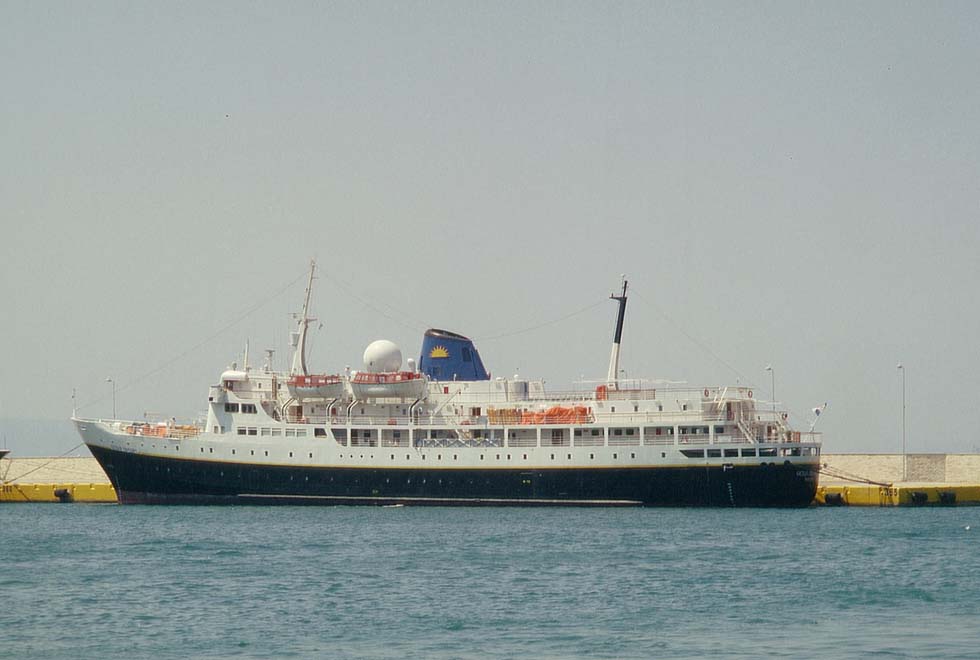
"Ocean Odyssey", the former "Eros", Piraeus 2006 (WS)
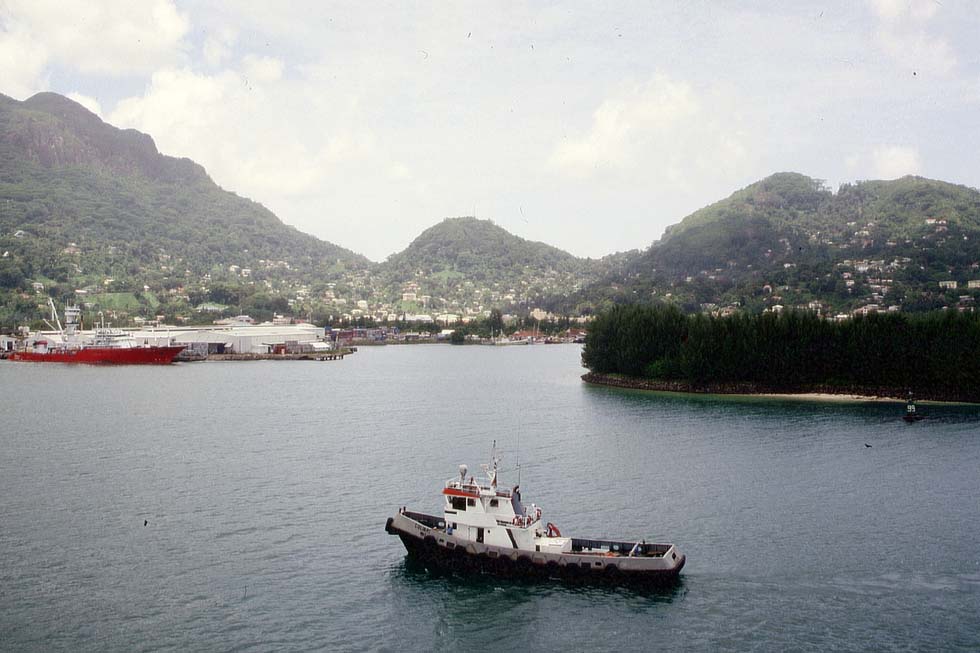
Port Victoria, Seychelles (WS)
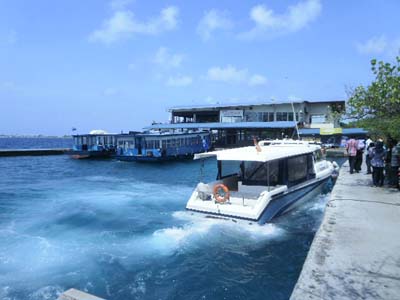 Airport Express at Male, Maldives 2012 (WS)
Airport Express at Male, Maldives 2012 (WS)
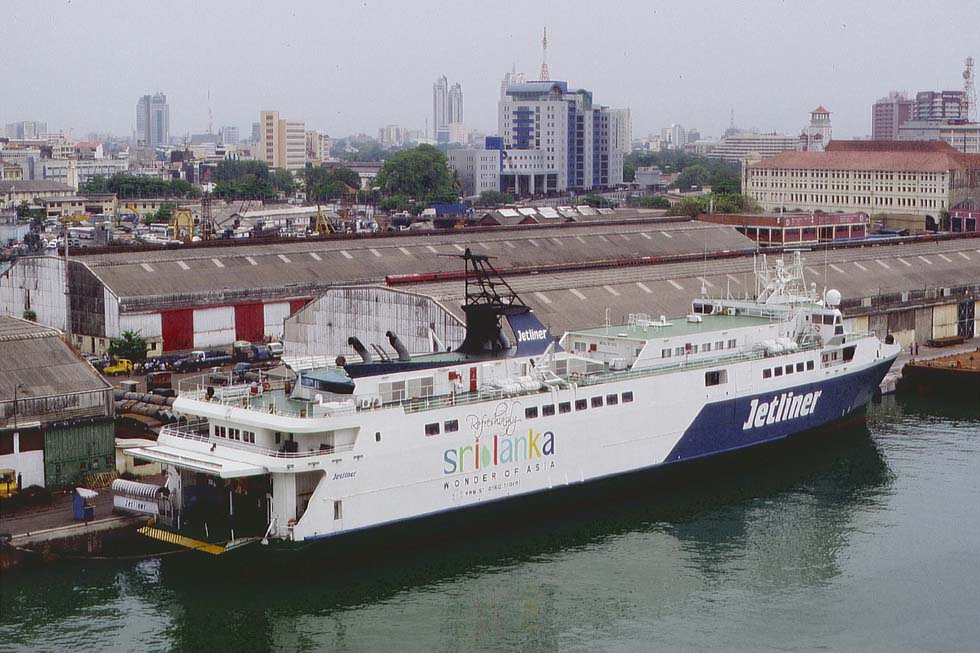
"Jetliner", Colombo, Sri Lanka 2012 (WS)
Sri Lanka Recovered
'The Wonder of Asia' is the label painted on the hi-speed car ferry "Jetliner", discovered lying at Colombo and in April 2012 a harbour police officer informed the author that it opened regular passenger services to Ramaswaram in India, once the port of departure (written Rameswaram) of the ferries to Talaimannar in Sri Lanka, abandoned due to the Tamiles' civil war. In India the connecting railway from Tambaram to Ramaswaram was temporarily closed for being converted to broad gauge.
The "Jetliner" of 4,563gt, sister of "Jet Ferry 1", had been the first car-carrying hi-speed monohull ferry in Britain, built at Bergen in 1996 for a speed of 31 knots, employed by P&O Irish Ferries until 2000, then by Norwegian Fast Ferries and by Pelni of Indonesia (according to www.ferry-site.dk). The further career was described by www.zoomsrilanka.com: She "served as a life line between the North and the East during the Humanitarian Operation." Then she provided short cruises, among others to Galle, "started from 22 January 2010 at the port of Colombo" (according to www.srilanka.travel.com). In that year 2010 www.jetliner.navy.lk informed about that enterprise: "The Nautical Enterprise under the name 'Visit Sri Lanka 2011' is a joint venture between Sri Lanka Navy and Sri Lanka Tourism Development Authority."
|